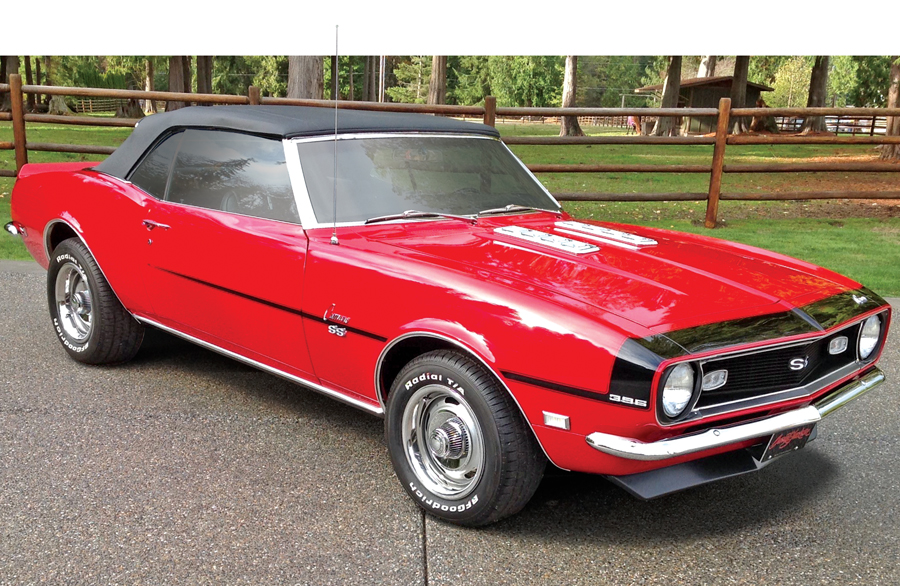SCM Analysis
Detailing
| Vehicle: | 1968 Chevrolet Camaro SS 396 replica convertible |
| Years Produced: | 1967–68 |
| Number Produced: | 16,927 (1968 V8 convertible) |
| Original List Price: | $2,908 |
| SCM Valuation: | $36,000 |
| Tune Up Cost: | $250 |
| Distributor Caps: | $13.56 |
| Chassis Number Location: | Driver’s side dashboard |
| Engine Number Location: | Milled pad below cylinder head, front passenger’s side |
| Club Info: | Camaro Research Group |
| Website: | http://www.camaros.org |
| Alternatives: | 1968 Mustang GT 390, 1968 Dodge Dart GTS, 1968 Pontiac Firebird 400 |
| Investment Grade: | C |
This car, Lot 772.1, sold for $74,800, including buyer’s premium, at Barrett-Jackson’s auction in Scottsdale, AZ, January 13–21, 2018. It was offered with no reserve.
Chevrolet had a knockout seller of a pony car with the 1967 Camaro, so 1968 was a year of careful tweaking instead of big changes. Small changes included an all-new Astro Ventilation system, which eliminated the side wing windows. Additionally, the grille and taillamps were revised. Camaro got a new console molded completely in plastic with saw-tooth gauges instead of a pot-metal top plate with circular gauges. The interiors were improved with expanded vinyl for a nicer feel and appearance.
Buyers went crazy when they saw the SS package, which originally was limited to the new 350 small block. By March of ’67, there was a 396 version available. For 1968, engineering changes included a switch to five-leaf rear suspension on high-output models, and staggered shocks, dashboard-mounted VIN plate visible on the driver’s side through the windshield, a vacuum-operated hideaway headlamp system for the Rally Sport and the continuation of the big-block SS 396 option introduced in March of 1967.
Evolution of the theme
For 1968, you could choose from four different 396 engines. They included the 350-hp L34, the 325-hp L35 or the 375-hp L78 solid-lifter monster. An aluminum-head L89 version of the engine also existed. The 396 came with a high-performance hood with twin non-functional stacked intakes. Transmission choices included Muncie close- and wide-ratio 4-speeds and a heavy-duty M22 along with the TH400. Hurst shifter handles didn’t appear until 1969.
The L34 was scarce, with 2,579 engines made. The L78 occupied the middle position, with 4,575 engines, while the L89 aluminum-head 396 is right up there with bigfoot sightings — just 272 made. The most common SS 396 Camaro was the L35, with 10,773 units produced. It’s what this car’s packing between the fenders, along with some very nice options like console, custom interior, pedal dress-up, tachometer power steering and power disc brakes. Finished like a brochure car in Matador Red with black fender stripes and Rally wheels, it was built to create envy and desire within every Chevy fanatic.
A do-it-yourself SS
Even Jim Phelps from “Mission Impossible” would be stumped searching for an SS 396 4-speed convertible. They just don’t show up that often. Production breakdowns by body style aren’t known, but demand has outstripped supply.
That’s one reason why our subject car, which started life as an inline 6-cylinder convertible, later became a stomping big-block SS. The VIN’s third digit is 3 instead of 4, revealing its original 6-cylinder status. The seller took a few liberties by adding chrome valve covers and spoiler package. Dolling up the car paid off with an out-the-ballpark figure when the gavel fell.
The ’68 L35 SS Camaros have been selling in the mid- to high-$40k range unless the car is a super-rare L78 or L89
example. This one got almost a third more than that — way above the ACC median recorded to date. But this sale doesn’t mean 1968 Camaros are on fire. If anything, it’s further proof that drivable classic cars are hot, as evidenced by a number of LS-powered pro-touring Camaros that sold for similar amounts at this same event.
In this case, clearly two people liked what they saw at a popular auction where TV cameras, good restorations and big prices are the norm. But within this successful sale also lies a bigger story being played out across the nation: an increased focus on usability, driver friendliness and guilt-free motoring.
Worry-free
Factory-original big-block Camaros aren’t ideal for modern road trips for a variety of reasons, but remove the numbers-matching part from the equation and suddenly the ride gets friendlier because the worry falls away. From there, owners can add hidden comforts such as an overdrive gearbox, modern rotating assembly and better brakes to make a lesser Camaro downright fun. If it does get in an accident, the stakes are relatively low — after all, we’re not talking about some expensive preserved original rarity here.
Up until now, that was the thought process. And then this car, and others like it at Barrett-Jackson, brought prices on par with what originals had been doing and blew most of that reasoning out of the water.
This was a stout price to pay for a Camaro that isn’t exactly what it appears to be, and that makes it very well sold, as you could buy something similar for a lot less — especially with an older restoration. But the truth of the matter is that building something like this from scratch would very likely cost close to what was bid here, and this one was reportedly just completed four months ago, so it’s as clean as they come.
There’s no doubt that the new owner paid a premium for this ride. Is it a trend or was it due to a couple of bidders simply trying to outdo each other in a high-profile setting? For that answer, we’ll just have to wait and watch.
(Introductory description courtesy of Barrett-Jackson.)
